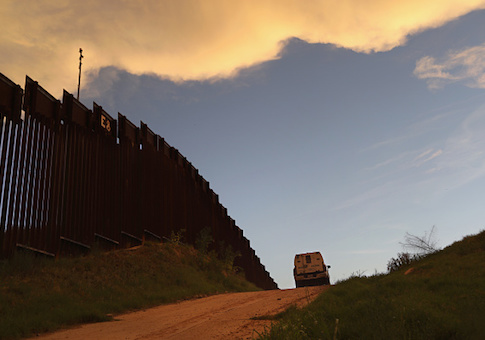The number of individuals apprehended trying to cross the border with Mexico fell for the second successive month in July, new data from U.S. Customs and Border Protection show.
31,303 individuals were apprehended trying to cross the border between ports of entry or at a port of entry without proper authorization. This is a decline from June, when 34,000 were apprehended. June, in turn, followed three straight months of more than 50,000 apprehensions.
The July drop actually deviates from the trend over the past five years, which—with the exception of FY 2014—have consistently seen numbers of apprehensions remain roughly constant between June and July. This makes last month's decline distinct from the June one, which itself was basically in line with recent trends and likely driven by the changing seasons as much as anything.
The Department of Homeland Security attributed this two-month drop to the administration's "zero-tolerance" policy, which requires that CBP refer every person it apprehends illegally crossing to the Department of Justice for prosecution for illegal entry.
"This decrease shows that when there are real consequences for breaking the law, the conduct of those considering crimes will change," said Tyler Q. Houlton, DHS press secretary, in a statement. "In the month of July, we saw a decrease in illegal border crossings because human traffickers and Transnational Criminal Organizations were put on notice that this administration was increasing prosecutions of those entering the country illegally."
The number of unaccompanied minors (UACs) apprehended at the border also fell substantially in July, from 5,000 in June to just under 4,000. The number of individuals apprehended as part of families—referred to as "family units"—remained roughly constant however, with a slight drop in apprehensions between ports of entry and an increase in apprehensions at ports of entry.
It's not obvious why the number of UACs has fallen, nor why the number of families has remained roughly constant. The administration's much-maligned family separation policy—by which parents are referred to DOJ for prosecution under zero-tolerance while their children are separately remanded to the Department of Health and Human Services—was brought to an end in June, although while it was in place it seemed to have little impact on family immigration.
While zero-tolerance has effectively ended for family units—and was never in place for UACS—the month-on-month decline that deviates from trend indicates that prosecution of individual adults may be having its desired effect. Houlton noted that "DHS is continuing to refer to DOJ single adult illegal border crossers for prosecution at historic rates."
Still, the effective end of zero-tolerance for parents, and a judge's refusal to modify the terms of the agreement governing children in immigration detention, means that a large portion of the group of people apprehended at the southern border face no criminal sanctions. Congressional efforts at fixes to the Flores settlement and other loopholes in current law have gone nowhere, leaving parents and DHS both frozen in an intractable situation.
"The number of family units apprehended at the border remains high and their percentage of total crossings has increased as court decisions prevent us from detaining and prosecuting family unit adults," Houlton said. "The inability to apply consequences to any law breaker ultimately threatens the safety and security of the nation and its communities."
